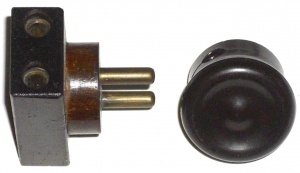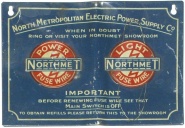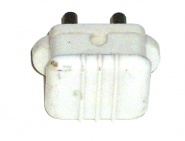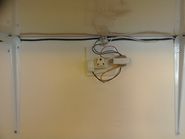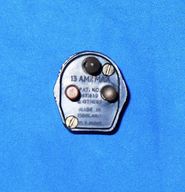Difference between revisions of "Dating Old Electrics"
Jump to navigation
Jump to search
| Line 69: | Line 69: | ||
*Accessories mounted on wooden [[pattress]] blocks: before 1966 | *Accessories mounted on wooden [[pattress]] blocks: before 1966 | ||
| − | *Round pin socket outlets (BS546 3 pin): mostly before 1955, but sometimes used much later, as in this example feeding a small transformer (the Clang adapter is old, and as it has unshuttered sockets shouldn't be used domestically)[[File:2amp3pinclangadapter.jpg|185px| | + | *Round pin socket outlets (BS546 3 pin): mostly before 1955, but sometimes used much later, as in this example feeding a small transformer (the Clang adapter is old, and as it has unshuttered sockets shouldn't be used domestically)[[File:2amp3pinclangadapter.jpg|185px|left]] |
*Square pin 13A sockets: post 1945 - may be on older wiring though | *Square pin 13A sockets: post 1945 - may be on older wiring though | ||
*2 pin 5A round pin sockets to BS372 (excluding bathroom shaver sockets, which are still in use): 1928 to 1930s, but also used later | *2 pin 5A round pin sockets to BS372 (excluding bathroom shaver sockets, which are still in use): 1928 to 1930s, but also used later | ||
*No sockets upstairs, or just 1 in corridor: typical 1930s practice. Exactly when this ceased the author doesn't know, most likely 1946 or 1947, but may be earlier | *No sockets upstairs, or just 1 in corridor: typical 1930s practice. Exactly when this ceased the author doesn't know, most likely 1946 or 1947, but may be earlier | ||
*Sockets with no shutters: | *Sockets with no shutters: | ||
| − | *D&S round pin 13A plugs/sockets, where the live pin is a fuse: 1940s on, some still in use in the 1980s [[File:Dormansmith2.jpg|185px| | + | *D&S round pin 13A plugs/sockets, where the live pin is a fuse: 1940s on, some still in use in the 1980s [[File:Dormansmith2.jpg|185px|left]] |
==Plugs== | ==Plugs== | ||
Revision as of 18:02, 23 July 2017
Some dates - but may contain errors, and sometimes things did get installed later than they should strictly have been.
(If you grab that wooden adaptor, you do indeed get hold of live tubes that come very close to the surface.)
Cables
- Lead sheath cable: some say before 1948, some say it was still being installed in the 50s. On farms it was used in the 60s.
- TRS (Tough Rubber Sheath) 1945-1962
- Capothene (rubber insulated, polythene sheath): 1952-1960
- Ashothene cable: 1952 - 1960
- PVC inner PVC outer T&E style cables with no cpc (no earth wire) (lighting circuits): 1955-1966
- Imperial PVC cables: 1955 - 1971
- 2.5mm² PVC/PVC T&E with 1mm² cpc: 1971 - 1981
- Twin twisted flexible cords: before 1977
- Single insulated figure of 8 speaker type flex used as mains lead: until 1976 in UK
- Rubber/PVC mix T&E cable: 1958 to 1961
- CMA (Cable manufacturers association) cable: ceased in the 1940s
- Non-association (Nonazo) cable: pre apx 1948
- Aluminium cable: popularish in the 1950s, and to a lesser extent the 1970s
- Copper clad Aluminium cable:
- Maconite cable (very distinctive O--O shape): pre WW2
- One you'll probably never see: very thick bare soft iron wire, used from late 1800s to 1920s on 32v generator powered lighting systems. System shown in the 1945 Agatha Christie film 'And then there were none'
- White insulated conductors: until 1966
Earth wire in cables
- Separate bare copper earth wires run alongside twin cable: 1960s and earlier
- Black earth conductors: before 1966
- Green protective sleeving: before 1977
- Green & yellow earth sleeving: 1976 onwards - 2nd ammendment (1 April 1976) to the 14th edition regs stated "The use of green alone as the colour identification of earthing coductors is admissable until 31 December 1977, after which the use of this colour may no longer be described as complying with these Regulations"
- Earth wires just twisted together at junctions: still common practice in the 70s
Cabling methods
Dates aren't especially accurate yet in this section
- Cables fixed to wall with ceramic cleats (small plates with grooves to hold the wire): pre WW1
- Wooden trunking:
- Rubber singles in steel trunking: popular in 1950s, most likely used in early 1960s too
- Uninsulated metal cable clips/cleats: still in use in the 70s
- Homemade junction boxes, typically a tobacco tin: pre-war
Main equipotential bonding
This refers to the main bond between electricity incomer and water/gas/oil incomers, nothing to do with bathroom equipotential bonding.
The dates here don't provide much certainty when dating an installation, as lots of houses were rewired later without updating the main bond.
- No main equipotential bonding conductor: before 1966
- 6mm² main equipotential bonding conductors: 1966 - 1983
- 10mm² main equipotential bonding conductors: post 1983
Fuseboards
- ELCB (Voltage operated circuit breaker): pre 1981
- Double pole fused switchgear on ac Installations: pre 1955
- Wood backed Wylex fuseboxes: still being installed in 1983
- Slate fuseboard with bare screws for fusewire links: in use in late 1800s, obsolete by the 1930s
- Wooden fusebox with wooden lid: standard in 1930s
- non-EEBAD installs (local earth rod but no ELCB or RCD): pre 1955
- Assorted switchfuses rather than 1 or 2 fuseboxes: until 1960s
- Ironclad fusebox & plastic version of: likely pre-war in domestic installs
Sockets
- Accessories mounted on wooden pattress blocks: before 1966
- Round pin socket outlets (BS546 3 pin): mostly before 1955, but sometimes used much later, as in this example feeding a small transformer (the Clang adapter is old, and as it has unshuttered sockets shouldn't be used domestically)
- Square pin 13A sockets: post 1945 - may be on older wiring though
- 2 pin 5A round pin sockets to BS372 (excluding bathroom shaver sockets, which are still in use): 1928 to 1930s, but also used later
- No sockets upstairs, or just 1 in corridor: typical 1930s practice. Exactly when this ceased the author doesn't know, most likely 1946 or 1947, but may be earlier
- Sockets with no shutters:
- D&S round pin 13A plugs/sockets, where the live pin is a fuse: 1940s on, some still in use in the 1980s
Plugs
Sometimes plugs can help date an appliance, but of course they were often reused and replaced.
- Wooden: until 1937. 1929 catalogue page from Sunco
- Machine age styling: typical 1940s
